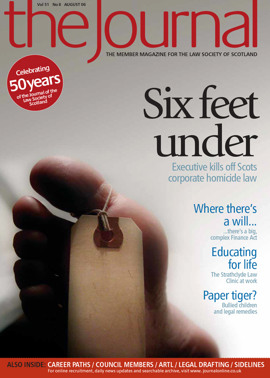Raising the stakes

“Groundbreaking” and “startling” were words used to describe the Court of Appeal’s decision in Majrowski v Guy’s and St Thomas’ NHS Trust [2005] IRLR 340, a decision now upheld by the House of Lords: [2006] UKHL 34. The case involved a claim brought under the Protection from Harassment Act 1997, which creates the criminal offence of harassment and affords victims a civil remedy in respect of both actual and threatened breaches. The question is, will Majrowski open the floodgates to claims against employers?
The facts
Mr Majrowski was employed by the Trust as a clinical auditor co-ordinator. He claimed he was harassed in various ways by his departmental manager, including her being rude and abusive to him in front of other staff; being excessively critical of his timekeeping and work; imposing unrealistic performance targets and threatening disciplinary action if he failed to meet them; and isolating him by refusing to talk to him.
Mr Majrowski is a gay man, and he claimed that his manager’s treatment was due to his sexuality. His internal grievance about her conduct was upheld. However, this all took place in 1998-99, long before the Employment Equality (Sexual Orientation) Regulations 2003 (SI 2003/1661). So, Mr Majrowski sought to bring a claim under the 1997 Act. However, he did not bring the claim against his manager, but against the Trust itself, asserting that it was vicariously liable for the actions of its employee.
The judgments
In the county court the claim was struck out, Judge Collins CBE holding that the 1997 Act was not designed to create another level of liability in employment law.
Then came the Court of Appeal decision, which held that employers could, in principle, be vicariously liable for breaches of a statutory duty committed by an employee in the course of employment, provided the statute neither expressly nor impliedly excludes such liability. The Lords have now unanimously upheld the appeal court.
The Scottish clue
Overlooked by both the county court and Court of Appeal was s 10(1) of the 1997 Act. Only applicable in Scotland, this provision was pointed out in the Lords by Lord Hope of Craighead.
The section amends the Prescription and Limitation (Scotland) Act 1973 to provide that the limitation period in a case should run from the date harassment ceases or, if later, the date “on which the pursuer in the action became, or on which, in the opinion of the court, it would have been reasonably practicable for him in all the circumstances to have become aware, that the defender was a person responsible for the alleged harassment or the employer or principal of such a person”.
This was seen as confirming that an employer can be held vicariously liable under the Act, as Parliament could not have intended the position in this respect to be different north and south of the border.
The consequences
So what does this mean for those who claim to have suffered harassment at work, and for their employers? As Lord Hope points out, there have only been eight reported cases in Scotland to date, despite the clear statutory indication that employers may be vicariously liable in damages. As an aside, having just checked her Butterworths Handbook, the writer cannot help but wonder whether this is in any way due to that publication’s omission of ss 10-13 of the Act, with only a note stating “[outwith the scope of this work]”.
The very fact of the Lords’ judgment will now focus the minds of advisers on the possibility of such a claim. The publicity and the fact that a claim does not need to be hooked on one of the discriminatory grounds – e.g. sex, race, disability, religion or belief, sexual orientation, or (from October) age – may well increase the number of claims by individuals and the threat of such claims during settlement discussions.
On top of this, in order to be awarded damages, pursuers need only prove “anxiety” or “distress”, as opposed to establishing they have a “recognisable psychiatric condition” to succeed in a personal injury claim. The time limit for bringing a claim is far longer than the usual three-month employment tribunal time limit (or six if the statutory dispute resolution procedures apply); and, finally, employers cannot rely on the “reasonable steps” defence which is available in the discrimination legislation.
The disadvantage is of course that the claim has to be brought in the civil courts, with their more prominent risk of expenses, rather than the employment tribunal.
In order to manage the heightened risk of claims which may prove costly to defend in terms of time and money, those advising employer clients should underline that their policies are kept up to date and that regular training take place in order to reinforce the message that harassment or bullying for any reason is unacceptable in the workplace.
Jane Fraser, Head of Employment, Pensions and Benefits,Maclay Murray & Spens
In this issue
- Ireland 4, Italy 0
- A lack of trust
- Technology and the Scottish courts
- For supplement read tax - an update
- Eyes on the ball
- Don't leave gaps in regulation
- Keeping company
- Fighting the bullies
- The university of life
- A lack of trust (1)
- With these few words...
- Tell it like it is
- All that sparkles ain't gold
- PDF is the standard
- The paper monster
- Safeguarding fair trial
- New law, new problems
- Raising the stakes
- Mark the pre-proof
- Scottish Solicitors Discipline Tribunal
- Website reviews
- Book reviews
- It takes two to tango
- Land attachment and suspensive missives
- PSG's suite moves






